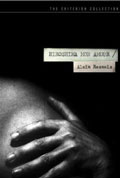
Directed by
Alain Resnais
91 minutes
Rated PG
Reviewed by
Bernard Hemingway

Hiroshima Mon Amour
After the success of his 1955 Holocaust documentary Night And Fog and after eleven years of making short films, Alain Resnais was commissioned to make a documentary about the atomic bomb. Unable to find the right concept he went to his producer and joked that the film could not be done unless Marguerite Duras, a leading light of the French literary avant-garde, was involved in writing the screenplay. The result, his first feature and a classic of Nouvelle Vague film-making, is the story of a Japanese architect (Eiji Okada) and a French actress (Emmanuelle Riva) who has come to Japan for a small part in a film being shot in post-war Hiroshima. The film switches between the characters’ present time, the actress's experiences during the Second World War when she had an affair with a German soldier, and the bombing of Hiroshima and its immediate aftermath.
The first twelve minutes or so of the film are simply a combination of very challenging images from the tragedy and extreme close-ups of the two naked lovers' bodies, the visuals overlain with a kind of poetic dialogic exchange between them as they establish the thematic terrain which they will travel over the film's remaining running time: love, desire, memory and its diminution and so on and so forth. Whether you can go the distance in what is a demanding and at times dated film will depend on your intellectual inclinations more than your emotional appetites, as being emblematically French, it is a wordily cerebral and angst-ridden depiction of two individuals trying to find true love in this crazy world, the film being a kind of highbrow literary take on Casablanca, the classic Hollywood romance which Resnais overtly references in the name of the bar which his two lover visit in the course of their long night of mutual angst.
Filmed in black and white with great style by Sacha Vierny and Michio Takahashi (handling the French and Japanese sections respectively), the words and images are beautifully harmonized with the sound design in one of the stand-out examples of the use of cinema to present psychological interiority, an approach Renais would take even further with Last Year At Marienbad two years later.
Want something different?





